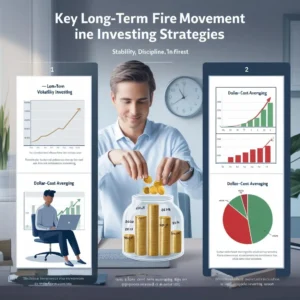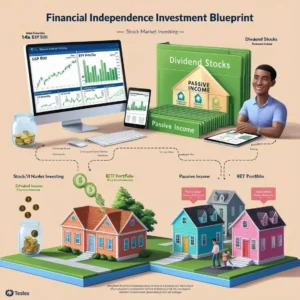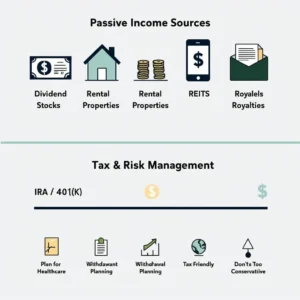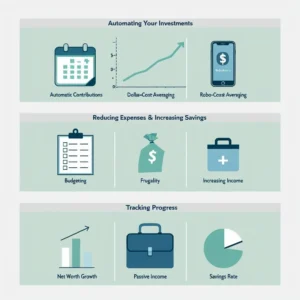✅ Financial Independence: The Path to Long-Term Wealth
Financial independence means reaching a point where your investments generate enough income to cover your living expenses, eliminating the need to work for money. Instead of relying on a paycheck, you can live off returns from your investments, whether they come from stocks, real estate, or other income-generating assets.
Investing is the key driver behind financial independence. While saving money is essential, simply stashing cash in a bank account isn’t enough to beat inflation or generate long-term wealth. Investing allows your money to grow exponentially through compounding, helping you build a financial cushion that supports your lifestyle indefinitely.

✅ Why Investing is Key to Never Working Again
At the core of financial independence is passive income—money that flows in without requiring active labor. This can come from dividends, rental income, or interest on bonds. Unlike a salary, which stops if you stop working, passive income continues to generate cash flow, making it a critical component of never having to work again.
Compounding returns play a crucial role in growing wealth. When you reinvest earnings from your investments, they generate additional returns over time, creating a snowball effect. The earlier you start investing, the more powerful compounding becomes.
Saving alone isn’t a viable strategy due to inflation and rising costs of living. A savings account might provide security, but its value erodes over time if it doesn’t grow at a rate that outpaces inflation. Investing ensures your money not only retains its value but also grows, giving you financial security and freedom.
Understanding Financial Independence & the FIRE Movement
✅ What is Financial Independence?
Financial independence occurs when your assets generate enough income to sustain your lifestyle without needing to work. This differs from traditional retirement, which often assumes people will work until their 60s, relying on pensions or Social Security.
Instead of relying on an employer or government benefits, financial independence allows you to control your time and money, giving you the freedom to pursue hobbies, travel, or engage in meaningful work on your own terms.
✅ Overview of the FIRE (Financial Independence, Retire Early) Movement
The FIRE Movement (Financial Independence, Retire Early) is a lifestyle approach that emphasizes aggressive saving and investing to reach financial independence faster than the traditional retirement timeline. Followers of FIRE aim to build enough wealth to retire decades earlier than usual, often in their 30s, 40s, or 50s.
The core principles of FIRE include:
- High savings rate – Many FIRE advocates save 50% or more of their income.
- Frugal living – Keeping expenses low helps accelerate savings.
- Investing for passive income – A well-structured portfolio generates returns that replace earned income.

People adapt FIRE to their personal goals, leading to different variations of the movement.
✅ Different Approaches: Lean FIRE vs. Fat FIRE vs. Coast FIRE
- Lean FIRE – Requires maintaining a minimalist, frugal lifestyle to retire early on a lower budget. This approach demands lower savings but also limits luxuries.
- Fat FIRE – Aims for financial independence with a higher standard of living, requiring a larger investment portfolio to support more expenses.
- Coast FIRE – Focuses on investing heavily early in life, then allowing compound interest to grow wealth without additional contributions. This allows individuals to transition to lower-stress or part-time work while waiting for their investments to reach full maturity.
Building a Strong Investment Strategy for Financial Independence
✅ Why a Long-Term, Low-Volatility Investing Strategy Matters
For financial independence, a long-term, low-volatility investing strategy is crucial. While high-risk investments can generate quick returns, they can also lead to significant losses. A steady, predictable approach reduces the chances of major downturns disrupting your financial goals.

Low-volatility investing helps protect your portfolio from market crashes, ensuring your wealth continues to grow consistently. Since financial independence depends on reliable income from investments, stability is key to maintaining financial security.
✅ How to Minimize Risk While Maximizing Returns
There are several strategies to balance risk and return:
- Dollar-cost averaging (DCA) – This strategy involves investing a fixed amount at regular intervals, reducing the impact of market volatility and avoiding the risks of investing a lump sum at the wrong time.
- Lump sum investing – Investing a large amount upfront can be beneficial if done during market dips, allowing for greater long-term growth. However, it carries higher short-term risk.
- Asset allocation – Diversifying across different asset classes (stocks, bonds, real estate, etc.) helps spread risk, ensuring that poor performance in one area doesn’t derail your entire financial plan.
Key Investment Vehicles for Early Retirement
✅ Stock Market Investing
The stock market is one of the most powerful tools for achieving financial independence due to its historically high long-term returns.
- Index Funds & ETFs – These are low-cost, diversified investment options that track entire market indexes, such as the S&P 500. They offer passive growth with minimal effort, making them a cornerstone of FIRE portfolios.
- Dividend Stocks – These stocks pay regular dividends, providing passive income while still offering capital appreciation. A well-structured dividend portfolio can cover living expenses, allowing for early retirement.
✅ Real Estate Investing
Real estate is another effective way to generate passive income and achieve financial independence.
- Rental Properties – Owning rental properties provides cash flow through rent payments, which can cover living expenses. Real estate also appreciates over time, increasing net worth.
- REITs (Real Estate Investment Trusts) – These offer a hands-off approach to real estate investing by allowing individuals to invest in property portfolios without managing tenants or maintenance. REITs generate income through dividends, making them a solid passive investment.

✅ Alternative Investments
Beyond stocks and real estate, alternative investments provide additional diversification and risk management.
- Bonds & Fixed Income – These investments offer lower returns than stocks but provide stability, making them essential for preserving wealth during market downturns.
- Gold, Crypto, and Other Assets – While riskier, assets like gold and cryptocurrency can serve as hedges against inflation and economic instability. Including them in a diversified portfolio can provide protection during uncertain times.
By strategically combining these investment vehicles, individuals can build a resilient portfolio that generates passive income and ensures a financially independent future—eliminating the need to work ever again.
Building a Diversified Portfolio for Financial Security
✅ The Importance of Asset Allocation
Asset allocation is the process of spreading investments across different asset classes to balance risk and return. It plays a crucial role in financial security because different asset classes perform differently under various market conditions.
The three main components of a well-allocated portfolio include:
- Equities (Stocks & ETFs) – Stocks offer the highest growth potential but come with volatility. Long-term investors rely on stock market growth to build wealth.
- Fixed Income (Bonds & Cash Equivalents) – Bonds provide stability and income, acting as a buffer against stock market downturns.
- Alternative Assets (Real Estate, Commodities, Crypto, etc.) – These investments provide diversification and protection against inflation.

A balanced mix of these assets reduces risk while ensuring steady growth, making asset allocation one of the most critical strategies for achieving financial independence.
✅ Diversification Strategies to Protect Against Market Volatility
Diversification minimizes risk by ensuring your portfolio isn’t overly dependent on one investment type. Here’s how to build a well-diversified portfolio:
- Across Asset Classes – Hold a mix of stocks, bonds, and real estate to balance growth and stability.
- Across Industries – Invest in sectors like technology, healthcare, consumer goods, and energy to avoid sector-specific downturns.
- Across Geographies – Spread investments globally to protect against economic downturns in any single country.
By diversifying wisely, you reduce exposure to market volatility while increasing long-term financial security.
✅ Rebalancing Your Portfolio Over Time
Over time, market fluctuations can shift your portfolio’s balance, increasing risk. Rebalancing helps maintain your intended asset allocation by periodically adjusting investments.
- When to Rebalance – Typically done once or twice a year or when an asset class drifts significantly from its target allocation.
- How to Rebalance – Selling assets that have grown disproportionately or adding more to underweighted areas.
- Why It Matters – Ensures your risk tolerance and investment strategy stay aligned with your financial goals.
Rebalancing is a key practice in maintaining financial independence and long-term stability.
Early Retirement Strategies: Making Your Money Last
✅ The 4% Rule & Safe Withdrawal Rate
The 4% rule is a common guideline for withdrawing money in retirement. It suggests that if you withdraw 4% of your portfolio each year, your wealth should last at least 30 years.
For example, if you have a $1 million portfolio, you can safely withdraw $40,000 per year.
However, market conditions can impact safe withdrawal rates. To adjust:
- In strong markets, consider withdrawing less than 4% to extend portfolio life.
- In downturns, temporarily reduce withdrawals to preserve assets.
- Diversify income streams to reduce reliance on portfolio withdrawals.

Understanding and adjusting your withdrawal rate is crucial for sustaining financial independence.
✅ How to Generate Passive Income Streams
To never work again, you need reliable passive income sources. Some of the best options include:
- Dividend Stocks – Regular payouts from companies provide steady cash flow.
- Rental Properties – Real estate generates income through tenant payments.
- REITs – Hands-off real estate investments that pay dividends.
- Bonds & Fixed Income – Offer lower returns but add stability.
- Side Businesses or Royalties – Digital products, online businesses, or book/music royalties can generate passive income.
A well-diversified mix of these sources ensures financial security and minimizes risk.
✅ Managing Taxes & Avoiding Common Pitfalls
Taxes can significantly impact retirement savings. Strategies to minimize tax burdens include:
- Tax-Efficient Investing – Use tax-advantaged accounts like IRAs and 401(k)s.
- Withdrawal Planning – Strategically withdraw from different accounts to avoid high tax brackets.
- Location Arbitrage – Consider living in tax-friendly states or countries to reduce expenses.
Common early retirement pitfalls to avoid:
- Underestimating expenses – Ensure your financial plan accounts for unexpected costs.
- Ignoring healthcare costs – Plan for medical expenses before traditional retirement benefits kick in.
- Being too conservative – Staying too safe with investments can result in running out of money.
By managing taxes and avoiding these mistakes, you can make your money last indefinitely.
Steps to Take Now to Achieve Financial Freedom
✅ Automating Your Investments
Automation removes the guesswork from investing and helps you stay consistent. Benefits of automating your finances include:
- Hands-Free Investing – Set up automatic contributions to retirement and brokerage accounts.
- Dollar-Cost Averaging – Invest the same amount regularly to reduce risk from market fluctuations.
- Best Tools – Robo-advisors like Betterment and Wealthfront, or automated transfers to index funds.
By automating your investments, you ensure steady progress toward financial independence.
✅ Reducing Expenses & Increasing Savings Rate
A high savings rate is one of the most powerful factors in reaching financial independence faster. Ways to increase savings:

- Budgeting – Track and optimize expenses using apps like YNAB or Mint.
- Frugality – Cut unnecessary spending while maintaining quality of life.
- Increasing Income – Negotiating raises, starting side businesses, or freelancing.
The more you save and invest, the faster you reach your goal of never working again.
✅ Tracking Progress & Adjusting Your Plan
Regularly assessing your financial independence progress helps ensure you stay on track. Key metrics to track:
- Net Worth Growth – Monitor investments and debt reduction.
- Passive Income Levels – Ensure your income streams cover expenses.
- Savings Rate – Aim for a high percentage of income saved and invested.
Adjust your plan as needed to optimize results and reach financial freedom sooner.
Conclusion
✅ Recap: Investing to Never Work Again
Achieving financial independence requires smart investing, disciplined saving, and strategic planning. The key principles include:
- Investing in low-cost, diversified assets for long-term growth.
- Using passive income sources like dividends and real estate to cover expenses.
- Following a low-volatility, risk-balanced strategy to protect wealth.
- Managing withdrawals and taxes efficiently to ensure sustainability.
By following these strategies, you can create a financial future where work becomes optional.
✅ Taking Action: Your Path to Financial Freedom
The best time to start is now. Whether you’re just beginning or refining your strategy, the key is consistent action.
- Start investing today – Even small amounts grow over time.
- Cut unnecessary expenses – Redirect savings toward financial freedom.
- Stay disciplined – Long-term success comes from persistence and smart decision-making.
With the right mindset and investment strategy, you can achieve financial independence—and never have to work again. 🚀

